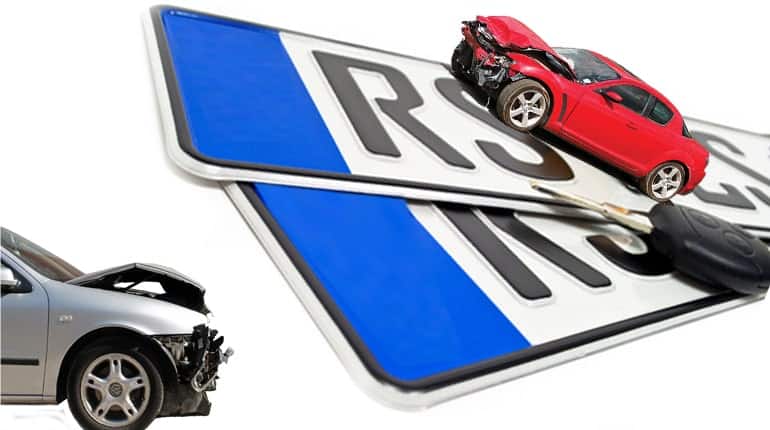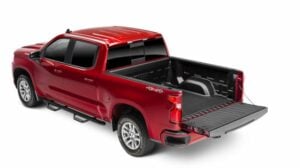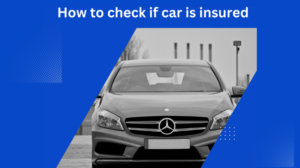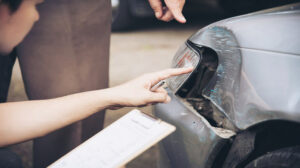Every car has to reach the end of its practicality one day. When that happens, you have to scrap it and inform the Driving and Vehicle Licensing Authority (DVLA) to get the car scrapped title. The DVLA issues the certificate of destruction once the Authorized Treatment Facility (ATF) completes its job.
Understanding the importance of car-scrapped check
While you may know how to scrap a vehicle or check if a car is scrapped, did you ever think about what happens to a number plate after the dismantle?
Well, when you scrap your vehicle, its number plate dies with it. You can never use that plate for any vehicle. Why? The reason is simple: a car’s number plate is its identity, and when a car dies, the number plate has to part with it.
When a car is scrapped, the number plates are usually surrendered and taken off the vehicle.
The process may vary depending on the country or region’s regulations, but in general, the plates are returned to the relevant government agency responsible for vehicle registration and licensing.
Removing the number plates ensures that they are not reused fraudulently, and it is a legal requirement to prevent unauthorized use of the registration.
Has my old car been scrapped?
It is extremely crucial to know your car’s scrapped status after you hand it over to an ATF. The ATF should send you Certificate of Destruction (CoD) within seven working days. If they do not, understand that they haven’t gotten a chance to scrap the vehicle. Or they have decided not to recycle it fully and instead chose to sell car parts.
Only a “depolluted, dismantled and recycled vehicle with a demolished metal frame” will need a CoD. Therefore, if your vehicle wasn’t destroyed and recycled, you do not have to fret about the CoD. However, you do need a letter from the DVLA telling you that you are not accountable for the vehicle. It is vital if you do not want to be liable for something that crops up after getting rid of the car.
How do I know the car scrapped status?
If you would like to identify the car’s scrapped status, you need to run the DVLA Scrapped Car Check. At Car Analytics, our car scrap check is part of our basic car registration check.
Once you run the number plate check, our system will search the DVLA database once you conduct the number plate history check to determine whether the car has been scrapped or not. If the car has a history of being scrapped, we’ll note that in our report. Walk away if the car’s scrapped status is “Yes.”
Please bear in mind that there is no such thing as DVLA scrapped car check-free. Car scrapped status check is a premium service, and it requires you to shell out just £1.99 with us. The same service can be ten times costlier in the HPI Check.
What happens to a personalized number plate when you scrap your car?
On the other hand, if you have a personalized or private number plate, keep it before sending the vehicle for scrapping. The DVLA has a say in everything from creating a number plate to what happens when you scrap your car. So, the most pressing question is, can you keep your personalized registration plate?
Can I keep my personalized number plate when I scrap my car?
Yes, you can keep your private plate and later use it for your new vehicle. However, you need to apply with the DVLA to keep it. Complete the V317 form at the Gov.UK website by giving the DVLA all the required details. It is a paid service, so you have to dish out £80. In case you would like to transfer this personalized plate to your new vehicle, you will require the present car’s logbook.
Bear in mind you can only apply for keeping the plate if the vehicle still has a valid registration with the DVLA.
How to keep your car’s registration number?
While we have briefly mentioned the process to keep your car’s registration number, we will go into detail here. There are two options for you: take advantage of the DVLA’s private registration retention service online or put your plate on retention through the postal service. Let’s discuss each option in detail.
Option A: Retaining your number plate online
The DVLA’s online personal registration retention service is the most convenient, and the fastest means to retain your number plate. You will require the following:
- The 11-digit logbook reference number for your vehicle
- A credit or debit card to pay the processing fee
Step 1:
Visit the DVLA’s online retention service online to fill out the form. Once you complete the process, you will get ownership of the private plate in question.
During the process, you need to provide the vehicle’s registration number you would like to keep, the logbook reference number, and the keeper’s postcode as given on the V5C document.
There is one thing you must know about and answer appropriately. Do you want to retain the private plate as a ‘grantee’ or a ‘nominee’? A grantee is an individual or a business that will receive the Vehicle Registration Retention Certificate. It means that a person or company will become the legal owner of the plate. You should choose a grantee if you are giving or selling the registration number to someone.
A nominee is someone who will become the owner of the plate when you shift it to his or her car. It is a perfect option if you intend to gift your personalized plate to someone.
The DVLA online retention service will set you back £80. You can avail the service daily from 7 am to 7 pm.
Step 2:
Once the process is complete, you get an electric confirmation from the Licensing Authority. The official V778 retention certificate reaches you within two weeks via post.
As you retain the private plate, your car gets a new registration number. You can now scrap it without worrying about losing your desired registration number.
Option B: Retain vehicle registration number through the post
Retaining your private plate number through the post is hectic as well as more time-consuming. To start the process, you will require:
- The car’s logbook whose registration number you want to keep
- A cheque, bank draft or postal order worth £80 – made payable to ‘DVLA Swansea’
Step 1:
The application is the same; just now, you need to fill out the DVLA V317 form by hand. You can download and fill out a copy. If you can’t, you can get it through DVLA’s form order service.
Step 2:
Ensure you have grasped everything written on the V317 guidance notes. Fill out the grey section on the form entitled ‘Option B’ by giving the registration number, make, model, and VIN/chassis details. You can find all this information in the logbook of the vehicle.
Step 3:
Here too you need to select either ‘grantee’ or ‘nominee.’ In the event you fail to fill this section, the presently registered keeper will get the retention certificate.
Step 4:
Examine the Option B/Section 2 part of the V317 form and ensure you dispatch all the required documents to the DVLA. Naturally, it consists of the V5C form and the payment proof (like a cheque, draft or postal order of £80).
Step 5:
Send the filled form and the supporting documents to:
DVLA Personalized Registrations
Swansea
SA99 1DS
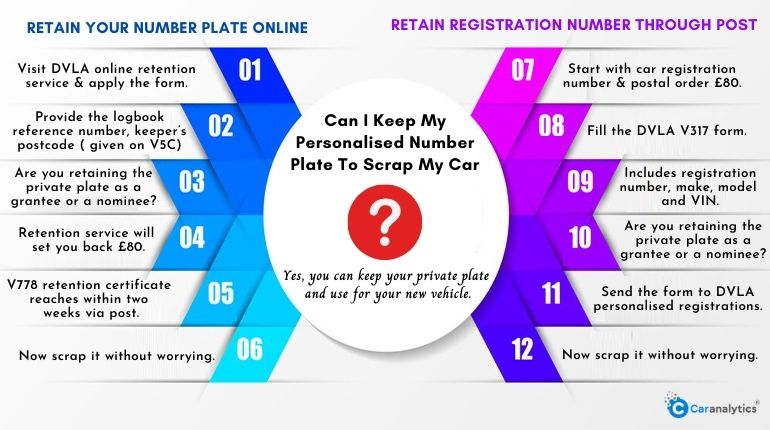
Conclusion:
When the time comes to scrap your vehicle, you must know the UK law. You can keep your private plate if you apply to the DVLA before vehicle scrapping. You must get the Certificate of Destruction (CoD) if you are sure your vehicle has been dismantled. To check a car’s scrapped status, you should always run a scrap car check. It would help if you always steered clear of a scrapped vehicle.
